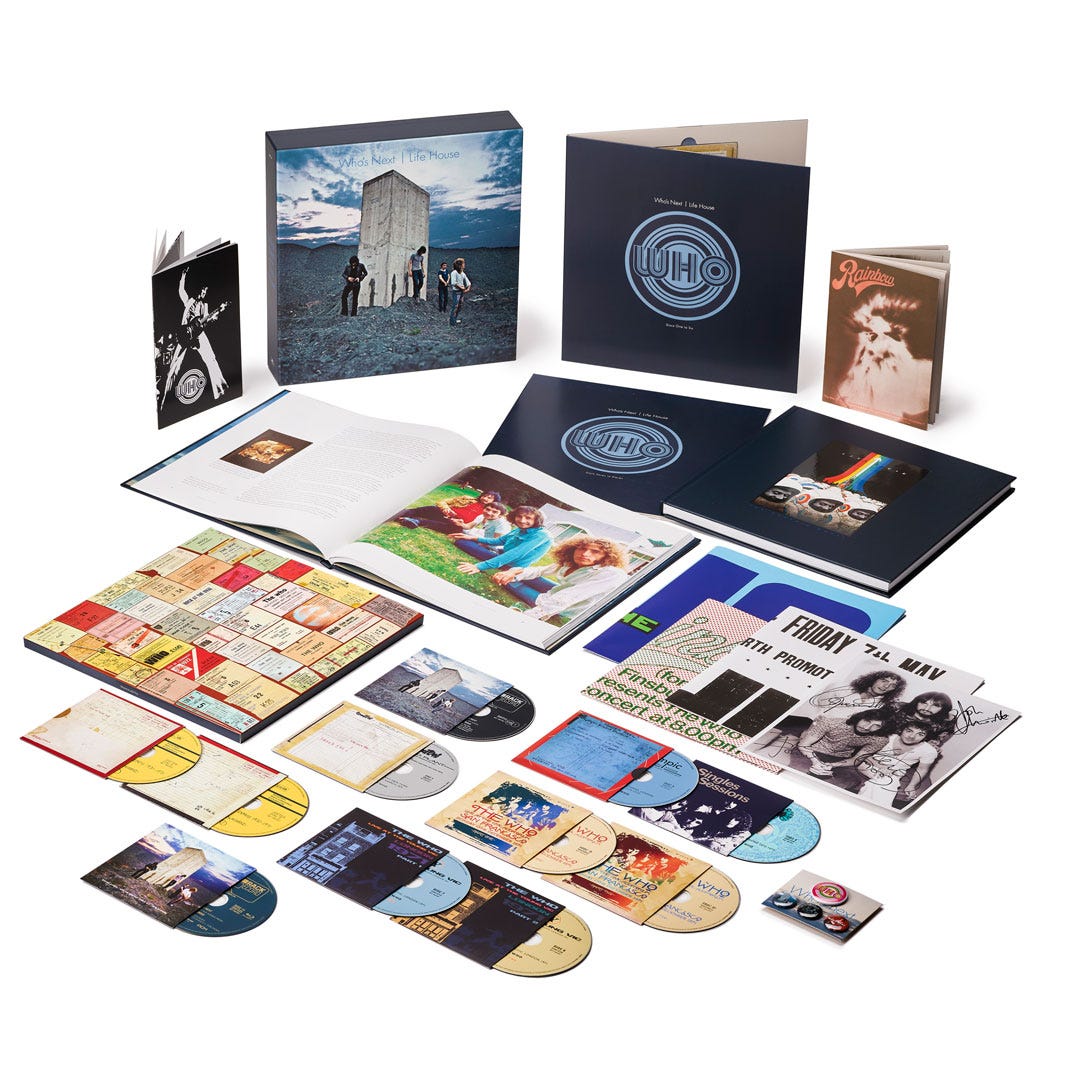Who’s Next / Life House Super Deluxe edition, The Who
(1971/2023)
Some box sets clobber you with too much material, others make you want yet more. Across 11 discs on the new Who Who’s Next / Life House Super Deluxe Edition, you dive in hoping for surprise, and instead discover a whole new thread to the Who’s catalog: the connective tissue between 1969’s Tommy and 1973’s Quadrophenia. The former typically gets over-praised, the latter remains vastly underrated. The package also helps explain the onslaught of tracks that appeared between Who’s Next and Quadrophenia with Meaty Beaty Big and Bouncy (1971) and Pete Townshend’s solo effort, Who Came First (1972).
Tommy’s triumph as a concert piece, and the band’s set in 1970’s Woodstock film, delivered them to top-tier status they had chased since 1965’s “My Generation.” And Townshend’s ambitions for his band seemed pulled along by his even larger ambitions for rock itself. There was a period when he must have dreamed only in concept albums.
The original Who’s Next, while classic, reached it final shape only after ditching the larger Lifehouse frame it first came in. Townshend released a version of this back in 2004 (called Lifehouse Chronicles across 6 CDs) that only made Who’s Next sound better. It’s still a matter for discussion whether Townshend even excels in long-form: Tommy has a kitchen-sink plot that turns its protagonist into a Guru who pities his needy followers, but where the story sags the music lurches forward into ever more bighearted refrains. (A major irony of Townshend’s power-chord status stems from how he turned the ringing open-body acoustic into a hard-rock trope: “Pinball Wizard,” “Goin’ Mobile”). Quadrophenia ditches plot for a cubist testimonial.
Townshend’s ambitions for his band seemed pulled along by his even larger ambitions for rock itself.
This box stays afloat on Townshend’s gangbusters guitar work alone, through alternate tracks, or familiar numbers with alternate solos. Like the banjo in “Now I’m A Farmer,” where Townshend barks the word “gourds,” “I Don’t Even Know Myself” has one in its bridge that makes it that instrument sound like his Gibson SG coming up for air. On a lesser number, “Here For More,” he plucks at his Gibson as though it’s a banjo; there’s a vaulting guitar solo in the middle of “Join Together” that was cut for time. (“Water,” once a live staple, has not worn well at all, and not just for its presumptive lyric.) Do banjo players make better rhythm players? How does Townshend’s lead style stem from such finger-picking?
And as the style’s leading guitar-rock thinker, Townshend writes beautifully for the grand piano. The master track to “Song Is Over” (Disc 5/11), features Nicky Hopkins, the Who’s fifth member, (keyboardist behind The Beatles’ “Revolution” and the Rolling Stones’s “Monkey Man”). Instead of sounding like vocal bedding, it soars like a concerto, a cascading loop that turns its I-V-IV progression into a revolving door of mounting tensions.
Producer Glyn Johns’s makes his presence felt through invisible cuts. Across all these B sides and outtakes, the best versions stand out by miles, and the edits lock in like fate. That guitar fanfare that opens “The Seeker” once sported an extra four bars, but the “radio” edit turns it into a freakishly gnarly act of brevity.
Discs 9 and 10 land on two concerts from 1971, the first from London’s Vic in April, the second from San Fransisco’s Civic Auditorium, which includes selections from Tommy. The first live rendition of “Pure and Easy” sallies forth with wings blazing, and works better than the Townshend “demo” and the band’s arrangement on MBB&B tracks would suggest. You can almost hear the tide coming in.
also
Stephen Thomas Erlewine, from “Time Is Passing” in his So It Goes newsletter: “A dynamic, possibly prescient concept, Lifehouse inspired passionate, thoughtful songs but Townshend lacked a crucial element: he couldn't wrangle his ideas into a narrative, not even one as mushy as the one that drove Tommy.”
Caryn Rose in Pitchfork (because of course she’s writing this up for Pitchfork): Lifehouse “has always been Townshend’s great white whale, a lost epic that he has revisited multiple times, trying to finally get it right…”
The Who.com: official site
the best part of breaking up
As we approach peak breakup season (two weeks before New Year’s), I fleshed out a breakup playlist—so beat the rush. You never forget what kinds of songs help you through those romantic gutters: some sly covers by singers I love (Dylan singing “I Could Have Told You”), stray originals that deserve more attention (Elvis Costello’s “Just a Memory”), prominent artifacts that never struck me as “breakup” songs until now (“Nothing Compares to You”), and buried comic delirium (Paul McCartney’s “Oh Woman Oh Why“).
noises off
substack archive, riley rock index: obits, bylines, youtube finds, reference sites, pinterest, beacons.ai





Oh my god! Wasp Man = Another Tricky Day!!
I have a LOT of Who to catch up on!!! Beginning with the Lifehouse Chronicles!!! Listening to a lot now! It has a lot of Scoop 1, 2, and 3 feel. But seriously listening to what ultimately became most of Who’s Next, talk about an alternate WHOniverse!!!!